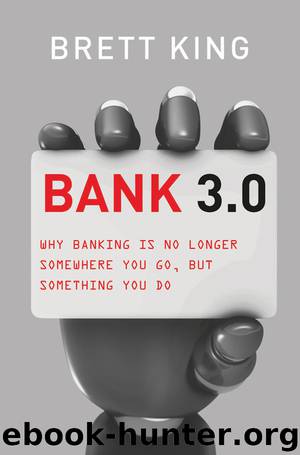Bank 3.0 by Brett King

Author:Brett King
Language: eng
Format: epub, azw3
Publisher: Wiley
Published: 2012-11-15T16:00:00+00:00
Chapter 7
The Evolution of Self-Service
Self-service banking—where it all started
Self-service devices in the banking world have traditionally been focused primarily on the ATM (Automated Teller Machine), with its mass launch in the 1970s in the US, and gradually over the 80s across the rest of the world. The ATM solved one of the biggest problems for a retail/commercial bank, that is, distribution of cash for customer withdrawals. Cash machines are an essential part of most consumers’ daily lifestyle; the ATM celebrated its 40th birthday in 2007, and today 75 per cent of all cash in the UK is dispensed to consumers via ATMs.
The invention of the ATM meant that one of the biggest fixed costs in any retail banking operation—the branch—could be reduced through branch rationalisation (closures). In addition, the variable cost component, staff, could also be reduced through downsizing. So, ATMs provided one of the biggest one-off saving hits for branch banking. The automation of one of the basic functions of a bank not only reduced costs, but also increased customer convenience, allowing access to cash 24/7.
That is where the story seems to have ended for ATMs. While there was the initial big roll-out and the promise of further automation of services through self-service, the promise has never really been delivered. Sure, ATMs have evolved in terms of their look, efficiency, speed, but their function, on the whole, is still concentrated on cash delivery.
The first mechanical cash dispenser was developed and built by Luther George Simjian and installed in 1939 in New York City by the City Bank of New York, but it was removed after six months due to the lack of customer acceptance. The first self-service device of any note that was a commercial success was the Automated Teller Machine launched by Barclays Bank in 1967. That device relied on a prepaid token to retrieve envelopes with a fixed amount of cash within. From this relatively primitive beginning, the ATM has gone on to revolutionise the banking habits of most retail customers.
Download
This site does not store any files on its server. We only index and link to content provided by other sites. Please contact the content providers to delete copyright contents if any and email us, we'll remove relevant links or contents immediately.
International Integration of the Brazilian Economy by Elias C. Grivoyannis(86515)
The Radium Girls by Kate Moore(11867)
Turbulence by E. J. Noyes(7895)
Nudge - Improving Decisions about Health, Wealth, and Happiness by Thaler Sunstein(7460)
The Black Swan by Nassim Nicholas Taleb(6948)
Rich Dad Poor Dad by Robert T. Kiyosaki(6319)
Pioneering Portfolio Management by David F. Swensen(6170)
Man-made Catastrophes and Risk Information Concealment by Dmitry Chernov & Didier Sornette(5878)
Zero to One by Peter Thiel(5638)
Secrecy World by Jake Bernstein(4594)
Millionaire: The Philanderer, Gambler, and Duelist Who Invented Modern Finance by Janet Gleeson(4300)
Skin in the Game by Nassim Nicholas Taleb(4123)
The Age of Surveillance Capitalism by Shoshana Zuboff(4118)
The Money Culture by Michael Lewis(4027)
Bullshit Jobs by David Graeber(3995)
Skin in the Game: Hidden Asymmetries in Daily Life by Nassim Nicholas Taleb(3868)
The Dhandho Investor by Mohnish Pabrai(3637)
The Wisdom of Finance by Mihir Desai(3607)
Blockchain Basics by Daniel Drescher(3430)
